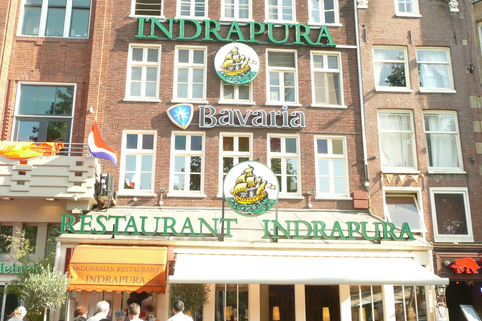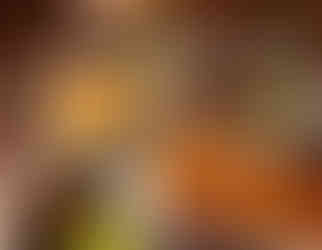We arrived in Amsterdam in the afternoon. After checking into our hotel and freshening up, we all assembled at the lobby for a welcome reception at a nearby restaurant. There were new people that joined us – those from South Africa who did not obtain their British visas and were advised to just fly directly to the Netherlands.
Our Tour Director told us we were going to be treated to a rijsttafel dinner at Indrapura, a very elegant Indonesian restaurant in the Rembrandtplein district where our hotel was located. At first, I wondered why we were going for an Indonesian meal in Amsterdam. I was aware that Indonesia was a Dutch colony and that the Dutch must have developed a taste for Indonesian food, but why were we not going to a Dutch restaurant to have a typical Dutch meal?
Then I started thinking if there was any Dutch delicacy that came to my mind. I tried hard but could not think of any. All I could conjure were images of tulips, wooden shoes, and wind mills. Oh wait…there is Edam cheese (more popularly known as "queso de bola," in the Philippines, for it is packaged as a ball of salty cheese wrapped in red wax, and is staple Christmas Eve item on Filipino tables, which is itself another interesting story*)…but what else do you eat with it aside from bread?
* The Philippines has never been a Dutch colony, but in the 1600s, the Dutch were at war with the Spanish (who colonized the Philippines) and were engaged in several naval battles around the islands, raiding Spanish posts. The Dutch brought with them Edam cheese, designed to last on long trade route voyages, and it became popular in Asia and even served as a "a maritime staple for officers in galleons." Its round shape was perfect for storage in barrels, allowing it to roll, which prevented bits of cheese from breaking off during transit, and also minimizes surface area that decreases loss of moisture through evaporation. The salt content and wax covering helped preserved the cheese for a long time, and even allowed it to ripen and become more flavourful.
As if reading my thoughts, the Tour Director, who is Dutch and is a resident of Amsterdam, said that Dutch cuisine is rather bland and it’s usually nothing special to rave about. It is very rustic and straightforward and, and one could say, lacking in the refinements that characterize the cuisine of its more sophisticated neighbours. Typical Dutch meals are bread with simple toppings eaten with cold cuts and cheese, or meat and potatoes supplemented with seasonal vegetables.
This rather simple and earthy take on food is a product of the Dutch experience during the war, exacerbated by the "Hunger Winter" in 1944, when one of the coldest winters on record descended on the country and froze all the waterways used as supply routes for food and other necessities...and that, in addition to the supply of gas and electricity being cut off. The people were forced to scavenge for wood to burn and for food to eat. On the same year, heavy rains also drenched the city and turned fields into mud. It was not so much as people were poor, but there was simply no food available, even if one had the money. By the spring of 1945, Dutch food supply lines were cut off completely and people were in the grip of famine, surviving on a slice of bread and a handful of vegetable per day.
Thus, one could say that one of the legacies of war was the Dutch attitude to food. Unlike their European neighbours that enjoy more delicate cuisines, the Dutch are contented with plain, but filling food - bread, cheese, potatoes, cabbage, and processed meat. Being fancy was not a priority. As well, while in other cultures, the kitchen is considered the centre of family life, in the Netherlands, the kitchen occupies just a small corner of the house, often adjacent to the living room, as if it were an after-thought. Food was traditionally cooked and consumed fast with no fuss and ceremony. Whatever was available in the market was what would be laid on the table. As long as there were potatoes, there was no need to bother with elaborate ingredients.
Since the arrival of former Dutch colonials from Indonesia though, more interesting dishes, along with a variety of spices and flavours were introduced and they have become part of what they now call “national dishes.” Some Indonesian recipes have been followed faithfully, but a kind of Indonesian fusion cuisine also evolved, including the rijsttafel (meaning “rice table), an elaborate meal consisting of many (even up to several dozens) of small dishes. It was based on the Indonesian feast nasi padang (a buffet consisting of rice, meat dishes, and vegetables) but tailored to the taste of the Dutch colonials to allow them to sample in one sitting, a whole range of dishes from Bali, Java, Sumatra, and countless others that made up what was then known as “The Spice Islands.”
We occupied two large tables at Indrapura, which filled up in no time with delectable Indonesian goodies. The serving dishes were cleared in no time as well, for the food was delicious, and after that long drive from Calais, we were all really hungry.
We had an array of fried rice and noodles, as well as a variety of meat dishes in sambal sauce (chili pepper condiment), peanut sauce, spicy coconut milk sauce, and Indonesian curries. Aside from the mains, there were side plates of mixed pickles, nuts spiked with grated coconut, mango salad, and potato sticks. Desserts consisted of banana fritters, rice cakes, and spekkoek, the classic Indonesian spice cake.
I was one of only two Southeast Asians in the group. The owner of the restaurant initially thought I was Indonesian (because I was familiar with the dishes and ate with gusto). When I told him that I am originally from the Philippines, he said, “Welcome, my neighbour!” and offered me a complimentary glass of their finest wine. I politely refused, saying I was pregnant and couldn’t have any alcoholic drinks. He gave me a non-alcoholic, milky cocktail instead.
Photo Credits:
globalblue.com, theguardian.com, meininger-hotels.com, businessinsider.com, Marion Golsteijn (Wikipedia), Владимир Шеляпин (Wikipedia), amsterdam-travel-guide.net, holland.com, eatingeurope.com, passportchop.com, fluentin3months.com





















Comments